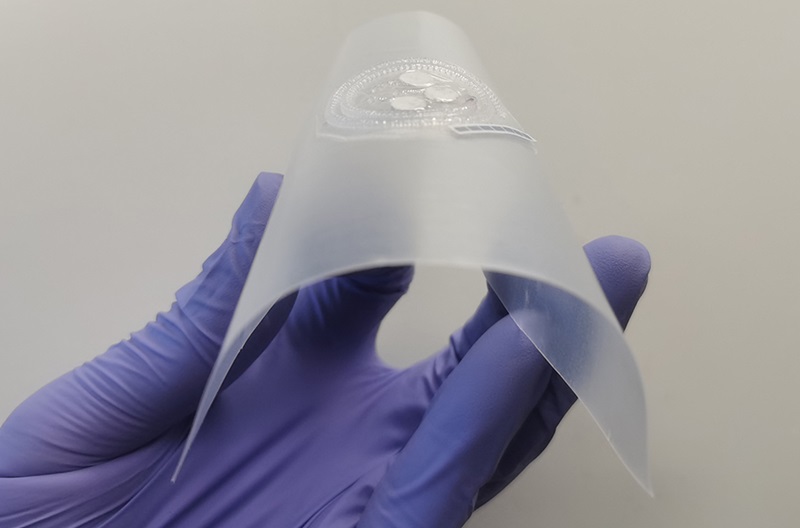Sweat Health Monitor Measures Levels of Disease Markers
|
By HospiMedica International staff writers Posted on 24 Jun 2024 |

Sweat contains critical metabolites indicative of various health conditions, and unlike blood, collecting sweat is non-invasive. Levels of uric acid in sweat can indicate risks for gout, kidney disease, or heart disease, while glucose and lactate levels are key indicators for monitoring diabetes and exercise intensity, respectively. However, these chemicals are present in minute amounts in sweat, making them difficult to measure. Despite numerous developments, existing sweat sensors are complex, requiring specialized fabrication equipment and expertise. These sensors must also maintain flexibility and stretchability. Now, a 3D-printed wearable health monitor can effectively measure important biochemicals in sweat during physical activity, promising a simple, non-invasive method for tracking health and diagnosing prevalent conditions.
Developed by a team at Washington State University (Pullman, WA, USA), this proof-of-concept health monitor was manufactured using a novel one-step 3D printing process. It utilizes a single-atom catalyst and enzymatic reactions to amplify signals and accurately measure low biomarker levels. The device includes three biosensors that change color to reflect concentrations of specific chemicals. Built with extremely fine channels, the monitor assesses both the rate of sweating and the concentrations of biomarkers without needing any supporting structures, which avoids potential contamination issues during removal.
Tests on volunteers have shown that this monitor consistently and accurately tracks glucose, lactate, and uric acid levels, as well as sweat rate during exercise, with the results matching lab performance. Originally designed to measure three biomarkers, the system's flexibility allows for the addition and customization of more biomarkers based on specific health monitoring needs. Volunteers also found the monitor comfortable to wear. The research team is currently focused on refining the design and validation of the device and is exploring opportunities to commercialize the technology.
“Sweat rate is also an important parameter and physiological indicator for people’s health,” said Kaiyan Qiu, Berry Assistant Professor in WSU’s School of Mechanical and Materials Engineering. “We need to measure the tiny concentrations of biomarkers, so we don’t want these supporting materials to be present or to have to remove them. That’s why we’re using a unique method to print the self-supporting microfluidic channels.”
Related Links:
Washington State University
Latest Critical Care News
- Neurorestorative Treatment Strategies Hold Promise for Most Severe Forms of Epilepsy
- Gene Discovery Could Help Grow New Heart Arteries
- Study Discovers Invisible Transmission of Common Hospital-Associated Infection
- Non-Invasive Neuro-Ophthalmology Techniques Could Detect Brain Tumors Earlier
- Mass Manufactured Nanoparticles to Deliver Cancer Drugs Directly to Tumors
- World’s Smallest Pacemaker Fits Inside Syringe Tip

- AI-Powered, Internet-Connected Medical Devices to Revolutionize Healthcare, Finds Study
- Starfish-Inspired Wearable Tech Enables Smarter Heart Monitoring
- AI Eye Scans Could Help Identify Heart Disease and Stroke Risk
- Digital Heart Twin Improves Diagnosis and Treatment of Cardiac Arrhythmias
- First-Of-Its-Kind AI-Powered Probability Scoring System Assesses Heart Failure with Preserved Ejection Fraction
- AI-Assisted Colonoscopy Detects More Polyps but Has Modest Effect on Cancer Risk
- Wearables Could Reduce Need for Continuous Blood Thinners in Patients with Atrial Fibrillation
- AI Model Provides Real-Time Sepsis Risk Alerts for Improving ICU Patient Survival
- AI Algorithm Improves Intravenous Nutrition for Premature Babies
- Smart Mirror Generates AI-Powered Health Insights by Analyzing Facial Blood Flow
Channels
Surgical Techniques
view channel
New Transcatheter Valve Found Safe and Effective for Treating Aortic Regurgitation
Aortic regurgitation is a condition in which the aortic valve does not close properly, allowing blood to flow backward into the left ventricle. This results in decreased blood flow from the heart to the... Read more
Minimally Invasive Valve Repair Reduces Hospitalizations in Severe Tricuspid Regurgitation Patients
The tricuspid valve is one of the four heart valves, responsible for regulating blood flow from the right atrium (the heart's upper-right chamber) to the right ventricle (the lower-right chamber).... Read morePatient Care
view channel
Portable Biosensor Platform to Reduce Hospital-Acquired Infections
Approximately 4 million patients in the European Union acquire healthcare-associated infections (HAIs) or nosocomial infections each year, with around 37,000 deaths directly resulting from these infections,... Read moreFirst-Of-Its-Kind Portable Germicidal Light Technology Disinfects High-Touch Clinical Surfaces in Seconds
Reducing healthcare-acquired infections (HAIs) remains a pressing issue within global healthcare systems. In the United States alone, 1.7 million patients contract HAIs annually, leading to approximately... Read more
Surgical Capacity Optimization Solution Helps Hospitals Boost OR Utilization
An innovative solution has the capability to transform surgical capacity utilization by targeting the root cause of surgical block time inefficiencies. Fujitsu Limited’s (Tokyo, Japan) Surgical Capacity... Read more
Game-Changing Innovation in Surgical Instrument Sterilization Significantly Improves OR Throughput
A groundbreaking innovation enables hospitals to significantly improve instrument processing time and throughput in operating rooms (ORs) and sterile processing departments. Turbett Surgical, Inc.... Read moreHealth IT
view channel
Printable Molecule-Selective Nanoparticles Enable Mass Production of Wearable Biosensors
The future of medicine is likely to focus on the personalization of healthcare—understanding exactly what an individual requires and delivering the appropriate combination of nutrients, metabolites, and... Read more
Smartwatches Could Detect Congestive Heart Failure
Diagnosing congestive heart failure (CHF) typically requires expensive and time-consuming imaging techniques like echocardiography, also known as cardiac ultrasound. Previously, detecting CHF by analyzing... Read moreBusiness
view channel
Expanded Collaboration to Transform OR Technology Through AI and Automation
The expansion of an existing collaboration between three leading companies aims to develop artificial intelligence (AI)-driven solutions for smart operating rooms with sophisticated monitoring and automation.... Read more


















